Narrow Gauge Railroads (USA): Width, History, Rail Lines
Last revised: February 27, 2025
By: Adam Burns
During the 1870's, a growing consortium viewed narrow gauge railroads as a cost effective and more efficient alternative to what became America's standard; 4 feet, 8 1/2 inches. While various widths were tested, ranging from 2 feet to 3 feet, 6 inches, promoters settled upon 3 feet as the optimal gauge.
Gauges of less than four feet were not new when the movement took hold. However, a national network was a modern approach. Unfortunately, proponents' founding principals were based entirely on hypothetical data, much of which was later proven erroneous by industry experts.
Nevertheless, the so-called "Narrow Gauge Fever" persisted, lasting through the mid-1880's before supporters finally recognized its flaws. During this time, more than 11,000 miles were placed into operation.
By 1890 the wave had passed and much of the network was either abandoned or converted. However, through the immediate post World War-II era (1946), more than 1,000 miles remained in use, scattered throughout the country.
All were isolated short lines or secondary branches. The section here provides a brief history of narrow gauge railroads, why they came so revered, and their eventual downfall.
Photos
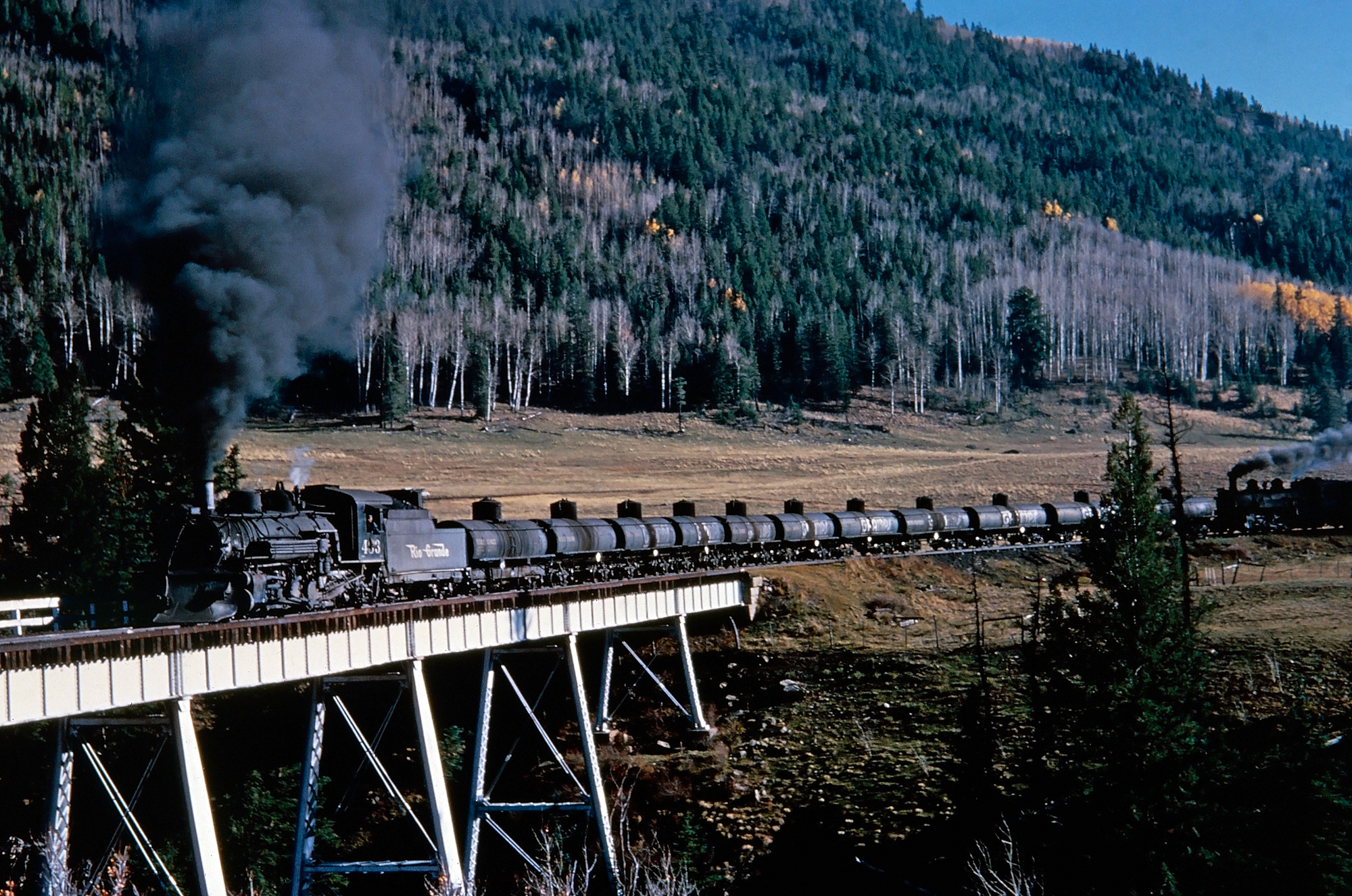 Rio Grande 2-8-2 #483 (K-36), and a helper, cross the Lobato Trestle in New Mexico with a loaded cut of Gramps tank cars as the train works its way towards the summit of Cumbres Pass in the fall of 1962. The oil was handled from a loading facility in Chama, New Mexico to a refinery at Alamosa, Colorado. American-Rails.com collection.
Rio Grande 2-8-2 #483 (K-36), and a helper, cross the Lobato Trestle in New Mexico with a loaded cut of Gramps tank cars as the train works its way towards the summit of Cumbres Pass in the fall of 1962. The oil was handled from a loading facility in Chama, New Mexico to a refinery at Alamosa, Colorado. American-Rails.com collection.History
The narrow gauge railroad is a complicated subject; it arose from no single event although was heavily influenced by Robert F. Fairlie. Similar to America's interurban movement, it witnessed a short lifespan that survived only a few decades.
In his comprehensive work entitled, "American Narrow Gauge Railroads," author and historian Dr. George W. Hilton describes in detail the movement and its overseas origins. If you are sincerely interested in the subject I strongly recommend finding a copy of his book. It is fascinating reading.
The information here primarily highlights the American movement with a brief look at its origins. It may be surprising to learn U.S. railroads of less than 4 feet, 8 1/2 inches date back to the industry's earliest days.
They became highly attractive in mining operations due to their cost savings and tight clearances. However, these were designed for specific purposes, not main line service.
The earliest known use of narrow gauge operations could be found on tramways and horse-drawn systems serving mines and quarries in the 18th, and early 19th, centuries.
Incredibly, though, there are writings that tell of even earlier operations in Europe dating back to the 13th, 15th, and 16th centuries. These were also tramways, carrying a gauge of about 2 feet, built to serve mines.
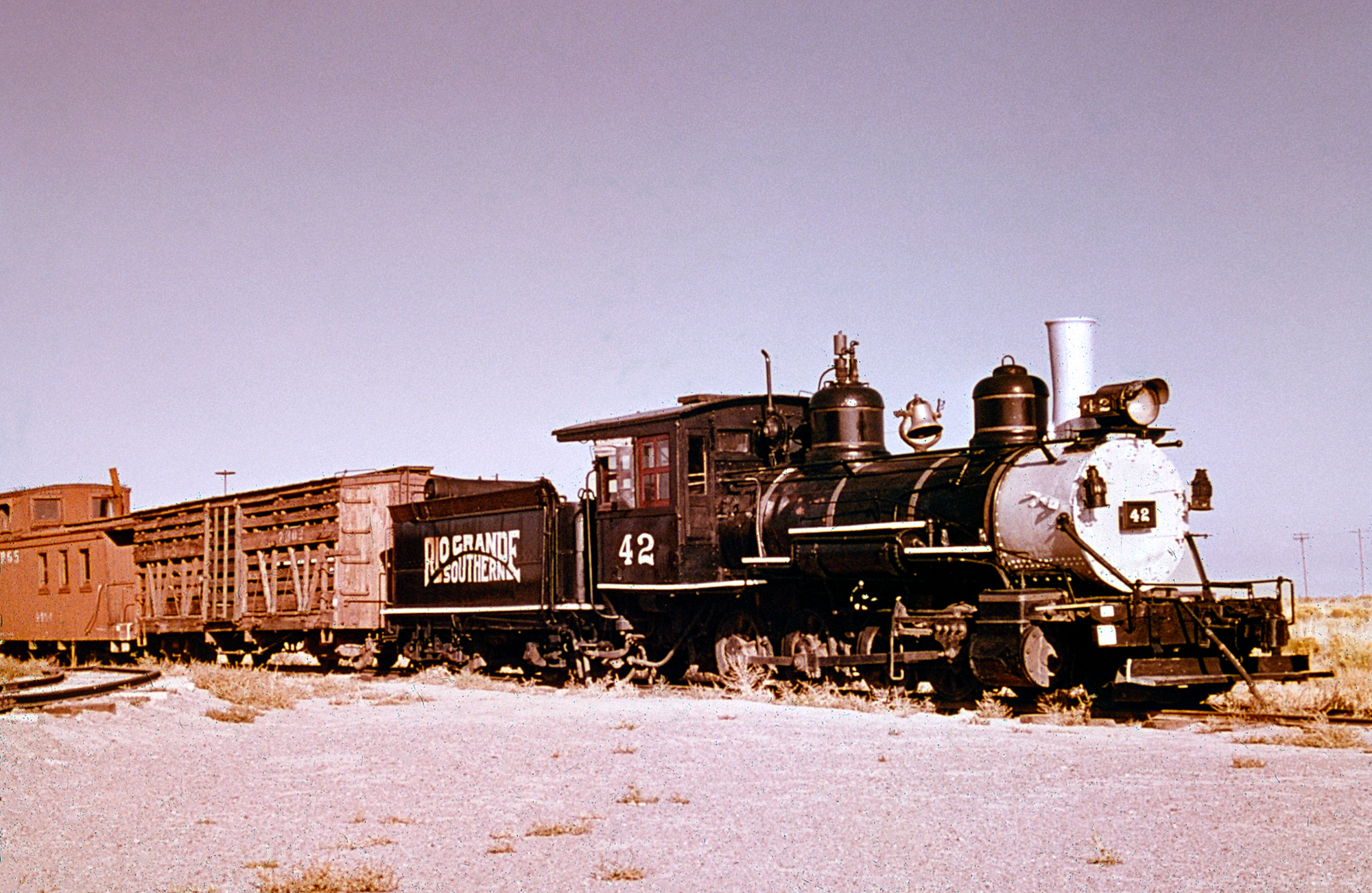 Rio Grande Southern 2-8-0 #42 (C-17) was photographed here at Alamosa, Colorado on the D&RGW by Robert LeMassena in 1952. American-Rails.com collection.
Rio Grande Southern 2-8-0 #42 (C-17) was photographed here at Alamosa, Colorado on the D&RGW by Robert LeMassena in 1952. American-Rails.com collection.Foreign Development
The modern narrow gauge movement began in Britain although its use in main line applications is widely credited to Carl Pihl, chief engineer of the Norwegian State Railways.
After consultation with British engineers, notably Sir Charles Fox, and the work of other Englishmen in the development of narrow-gauge locomotives (principally Isaac W. Boulton, John Smith, and John Ramsbottom between 1861-1862), Pihl was ready to begin construction.
A gauge of 3 feet, 6 inches was selected with 2-4-0 and 4-4-0 tank locomotives (of British design) chosen as the primary power.
His first line, running 38 kilometers (23.61 miles) opened between Hamar and Elverum, Norway on June 23, 1862. Just two years later, on August 5, 1864 a second route, running 49 kilometers (30.45 miles) opened between Trondheim and Storen according to the Norwegian publication "Norges Jernbaner, 1958-1959."
The previously mentioned Fox also believed in the narrow gauge concept. He felt its lower construction and [perceived] operational costs made it a far more attractive alternative to 4 feet, 8 1/2 inches.
As such, he built a 3 foot, 6 inch line in India (then a British colony) running 16 miles from Arconum Junction to Conjeveram, which opened in May, 1865.
Another British territory, Queensland (Australia), opened is own 3 foot, 6 inch railroad on July 31, 1865. This particular project ran 20 miles from Ipswich to Grandchester and was another in which Sir Charles Fox was involved.
In every case, the railroads proved quite successful, in part due to their isolated location, disconnected from competing gauges.
Their success brought forth an individual who would prove instrumental in narrow gauge railroads reaching the United States, Robert F. Fairlie.
Born in 1831, he began his railroading career at the London & North Western and later became chief engineer and general manager of the Londonderry & Coleraine Railway in 1853/1854.
By the 1860's he was a consulting engineer and through his experience believed locomotives were too heavy, equipped with many needless un-powered axles. As a result, he designed his own wheel arrangement, the 0-4+4-0 in 1864/1865.
Fairlie Type
Later known as the "Fairlie Type" it was not necessarily a new invention and heavily criticized by experts at the time. In any event, his beliefs led him to the conclusion that 4 feet, 8 1/2 inches resulted in the equipment's tare weight (weight of an empty car) being too heavy for traditional transport of passengers and ladding (freight).
Fairlie's first experience in locomotive production proved a disaster for Australia's Queensland Railway, where a series of 0-6+6-0 designs were a complete failure. He persevered, however, and had more success with an 0-4+4-0 arrangement which found use on the Ffestiniog Railway in Wales.
This operation, which originally opened on April 20, 1836 to transport mined slate from quarries near Blaenau Ffestiniog to the coastal town of Porthmadog, was working to convert its horse-powered tramway to steam-powered locomotives (the Ffestiniog remains in service today as a highly successful tourist attraction).
When Fairlie's initial example went into service in October, 1863, the Ffestiniog earned the distinction of being the first to utilize a steam locomotive in a narrow gauge setting. The 0-4+4-0's success gave Fairlie increasing support as he continued to push for expanded narrow gauge service throughout other parts of the British Empire.
He eventually settled on the width of 3 feet as the most practical. Back in America, the narrow gauge was not entirely novel; the Mauch Chunk, Summit Hill & Switchback Railroad, a division of the Lehigh Coal & Navigation Company, had been hauling anthracite coal from mines near Summit Hill, Pennsylvania via a 3 foot, 6 inch mule and gravity-powered railroad since operations were launched on May 5, 1827.
- The 9-mile line used mules for the ascent and gravity on the descent. It installed two inclined planes in 1844 and was converted to a tourist attraction in 1870. -
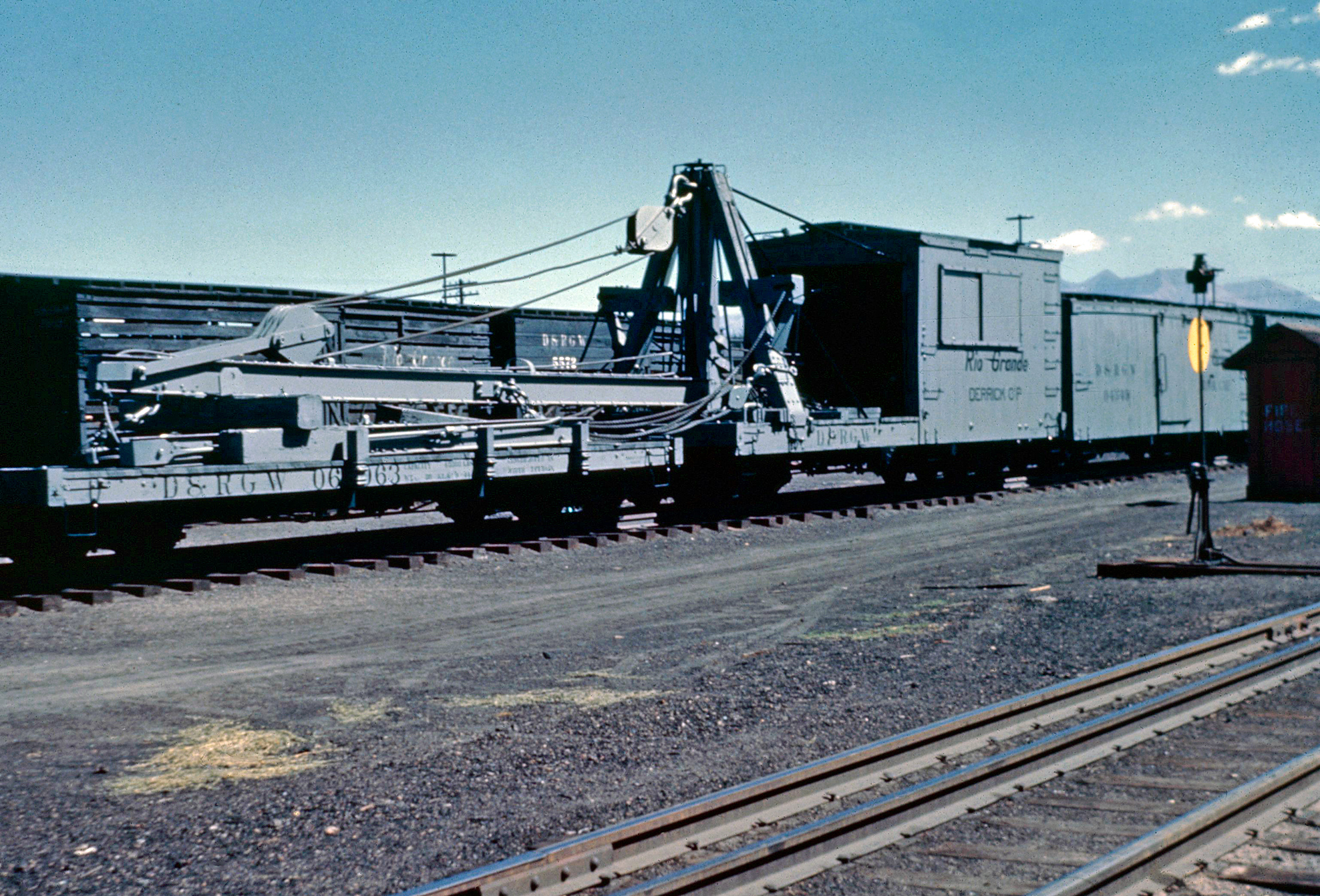 Rio Grande narrow-gauge steam derrick "OP" was photographed here at Alamosa, Colorado in September, 1944. American-Rails.com collection.
Rio Grande narrow-gauge steam derrick "OP" was photographed here at Alamosa, Colorado in September, 1944. American-Rails.com collection.In addition, the Delaware & Hudson Canal Company's early railroad from Scranton to Honesdale was designed to a gauge of 4 feet, 3 inches while even the Baltimore & Ohio, our country's first common-carrier, initially went with a 4 foot, 6 inch gauge.
There is no single factor that explains why many early American railroads opted for the width of 4 feet, 8 1/2 inches.
While it did offer better stability and additional per-car tonnage, many felt uniformity with British practice, a country which had long since established the gauge as its standard, improved efficiency. At the time, Britain produced nearly all iron rails and locomotives found throughout the world.
The later proliferation of 4 feet, 8 1/2 inches throughout the United States, particularly by the 1870's, happened largely by accident as the industry sought an optimal gauge for improved service (and, ultimately, greater profits).
This single factor is what ultimately doomed narrow gauge promoters in their efforts to build a national network. They used hypothetical figures to promote their agenda. In many cases, few had actual experience in rail operations (to learn more about these numbers, again, please read Mr. Hilton's book).
Where narrow gauges had been successful, proponents often ignored the fact these were disconnected operations, or part of a larger network free from competition.
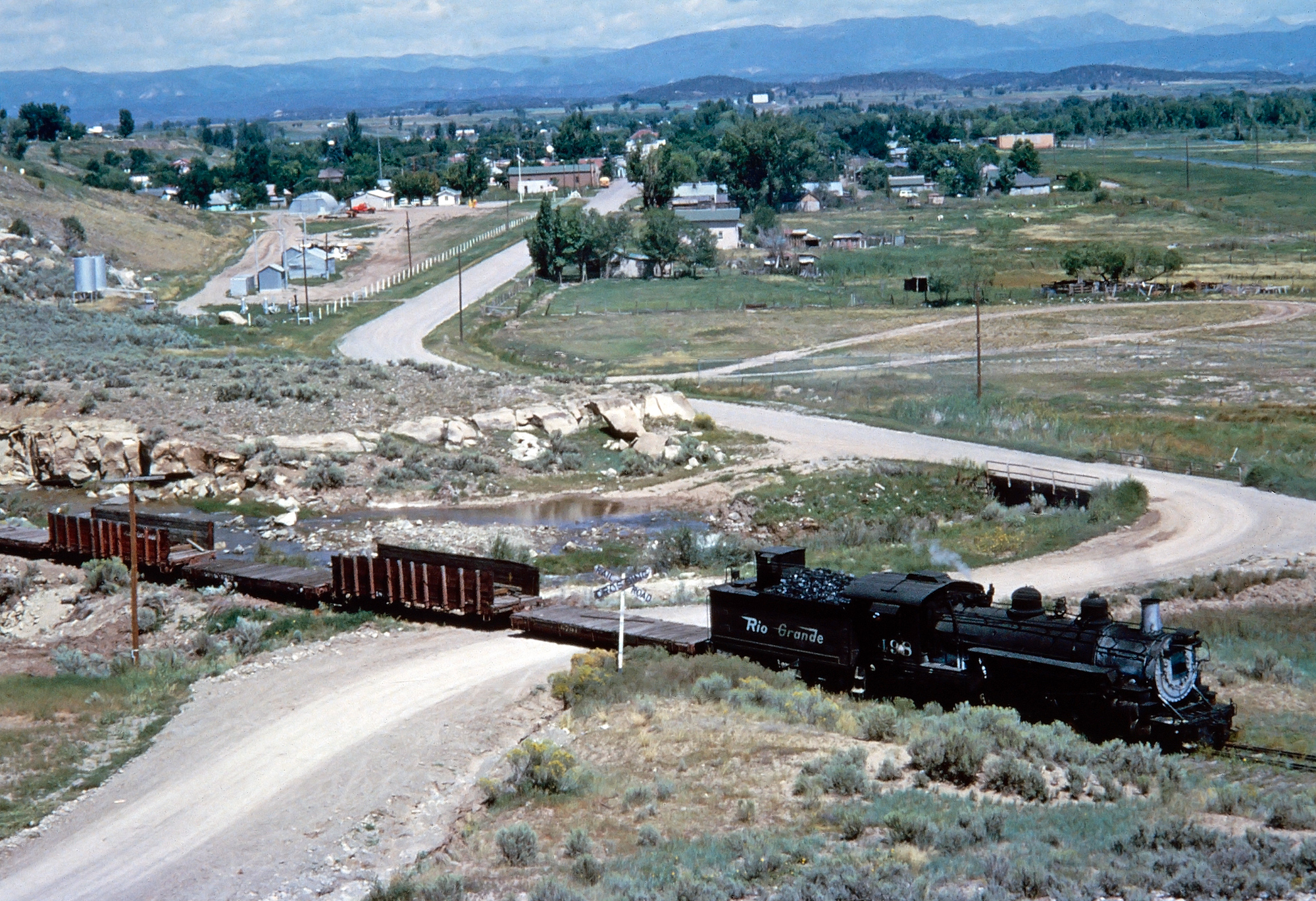 Rio Grande 2-8-2 #498 (K-37) leads an eastbound along the narrow-gauge San Juan Extension east of Durango, Colorado in the summer of 1968. American-Rails.com collection.
Rio Grande 2-8-2 #498 (K-37) leads an eastbound along the narrow-gauge San Juan Extension east of Durango, Colorado in the summer of 1968. American-Rails.com collection.Denver & Rio Grande Railway
Two events occurred in 1870 which set into motion widespread use of narrow gauge railroads across America; on September 19, 1870 Robert Fairlie presented his work entitled "On The Gauge For The Railways Of The Future" to the British Association for the Advancement of Science at Liverpool, England (it was reprinted in the Railway Gazette on October 15th) and General William J. Palmer chartered the Denver & Rio Grande Railway on October 27, 1870.
Construction of Palmer's railroad, which he intended to link Denver with Salt Lake City (via Grand Junction) and El Paso, Texas (via Veta Pass and Alamosa) as well as serve the lucrative silver mines in southwestern Colorado, began on July 28, 1871.
After losing the famous battle with the Atchison, Topeka & Santa Fe for access over Raton Pass, the D&RG never reached Texas and the Rio Grande River.
However, it did prosper as the region's only efficient crossing of the Rocky Mountains. Despite failing to reach the Mexican border, Palmer's railroad was completed largely as he had originally envisioned. To read more about its history please click here.
Its success only further spurred narrow gauge proponents. Finally, while Palmer established what ultimately became America's largest and most profitable 3-foot system (its network peaked at 1,673 miles in 1887), a gentleman by the name of Colonel Edward Hulbert promoted narrow gauges in the Southeast.
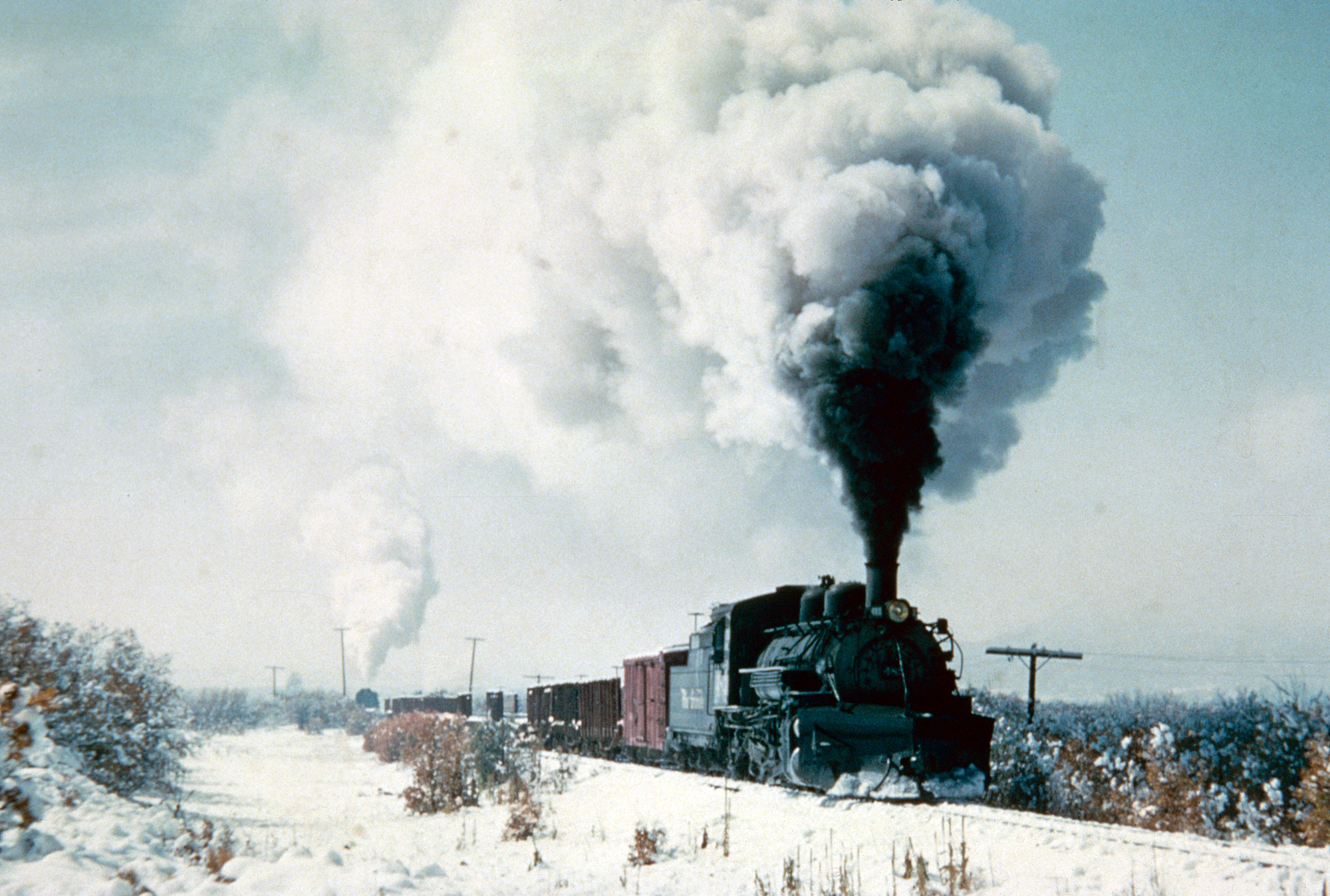 Rio Grande 2-8-2 #483 (K-36) and mate work hard shoving empties over Cumbres Pass. Date not recorded. American-Rails.com collection.
Rio Grande 2-8-2 #483 (K-36) and mate work hard shoving empties over Cumbres Pass. Date not recorded. American-Rails.com collection.He entered the railroad industry in 1848 as a freight clerk on the Atlanta & West Point, and slowly rose through the ranks, eventually becoming superintendent of the Western & Atlantic in 1868.
He gave his first public speech regarding the narrow gauge concept on February 14, 1871 and later released a pamphlet in August, 1871 entitled, "The Narrow Gauge Railway."
The work concerned subjects and arguments previous promoters had already covered, such as lower operational and construction costs. It was quickly dismissed by opponents.
Nevertheless, with interest growing, a National Narrow-Gauge Railway Convention was held in St. Louis at the Southern Hotel on June 19, 1872 where advocates spoke about the gauge's benefits and tried to convert skeptics (a second convention was held at the Lookout House in Cincinnati on July 17-18, 1878).
It had some success in the latter but its greatest achievement was adopting a series of standard practices with its "Committee of Eleven" agreeing on a principal gauge of 3 feet with a height of 24 inches from the rail to the coupler's center.
In 1871, there were only 97 miles of narrow gauge railroads in service but just four years later, this number had jumped to 1,474 miles. Over the next decade, many thousands more would be built. The financial Panic of 1873 inhibited construction, but only briefly; by 1880 there were 6,200 miles in operation.
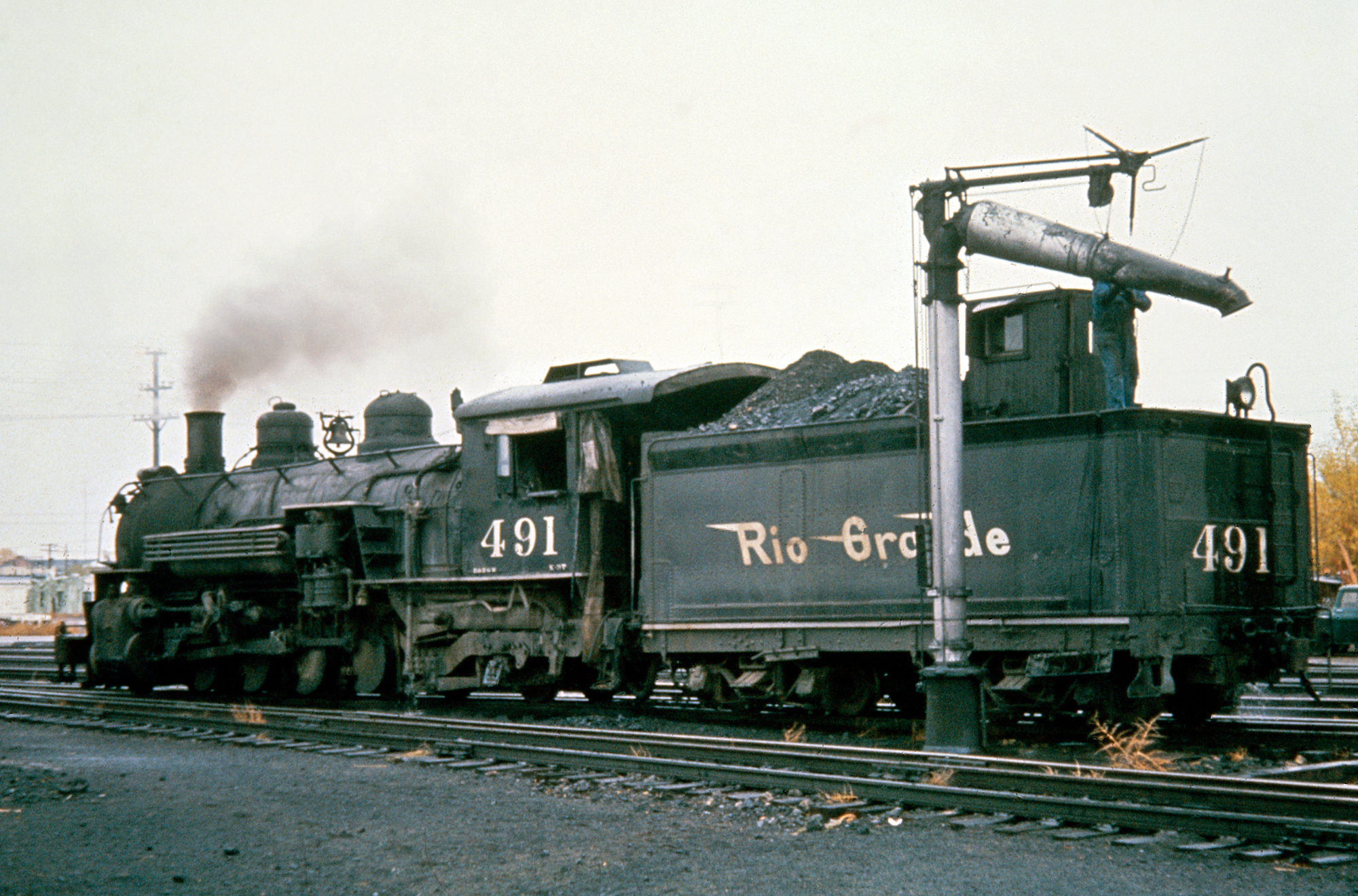 Rio Grande 2-8-2 #491 (K-37) takes on water in Alamosa, Colorado during the 1960s. American-Rails.com collection.
Rio Grande 2-8-2 #491 (K-37) takes on water in Alamosa, Colorado during the 1960s. American-Rails.com collection.Peak Years
Even prior to the great "Narrow Gauge Fever" of the 1880's, cracks in the ideology were developing; there was an increasing number of detractors (such as the Gazette's Matthias Nace Forney, Benjamin H. Latrobe [a respected railroad engineer who was the Baltimore & Ohio's chief engineer in its early years], and Silas Seymour [another noted engineer who worked his way up through the Erie Railway's ranks, eventually reaching the status, chief engineer of construction]).
The most damning testimony came from an individual who had actual experience in narrow gauge operations; Lorenzo M. Johnson, general manager of the Cairo & St. Louis Railroad.
The C&StL was a very early 3-foot system, chartered in 1865 with intentions of linking Cairo, Illinois, along the Illinois Central's main line, with St. Louis.
When opened on March 1, 1875 the C&StL boasted a 150-mile system, then the longest of its type in service. It proved one of the more successful operations (predominantly thanks to its coal business) but Mr. Johnson's testimony regarding costs must have dismayed promoters.
In the September, 1878 issue of Scribner's Monthly, in a piece entitled "Are Narrow-Gauge Roads Economical?," Johnson flatly laid out actual real dollars and cents regarding how a narrow gauge railroad stacked up against its standard gauge counterpart. Some of his remarks were as follows:
"The labor involved in the construction of a narrow gauge coach is very nearly the same as that required to construct a standard gauge coach, although the quantity of materials required will be less."
"I need not make a detailed statement of the cost of building these cars or coaches, since it will be obvious that three narrow gauge coaches will cost as much as two standard gauge coaches."
"Very little is saved in the equipment of a narrow gauge road with locomotive power, for a small engine will not do so much work in proportion to its cost as a large engine, and a million tons of freight can be hauled over any road with less cost for motive power with a large engine of a standard gauge road than with a small engine of a narrow gauge road. "
"More engines will be required to haul a million tons of freight on a narrow gauge road than on a standard gauge road; moreover, the lighter engines do not execute their work so satisfactorily, as they get out of order more frequently..."
"Let any man who is seeking for investment of capital in railway construction, consult those who have operated both classes of roads, and he will be advised, almost invariably, that he will save very little in cost of construction, equipment, and operation, and that he will lose business from competition, if he adopts the narrow gauge."
Despite his words, the movement had gained too much momentum to be slowed as dozens of projects were still slated through the 1880's. Mileage rose to over 10,000 in 1883 and reached its zenith in 1885 at 11,699 miles.
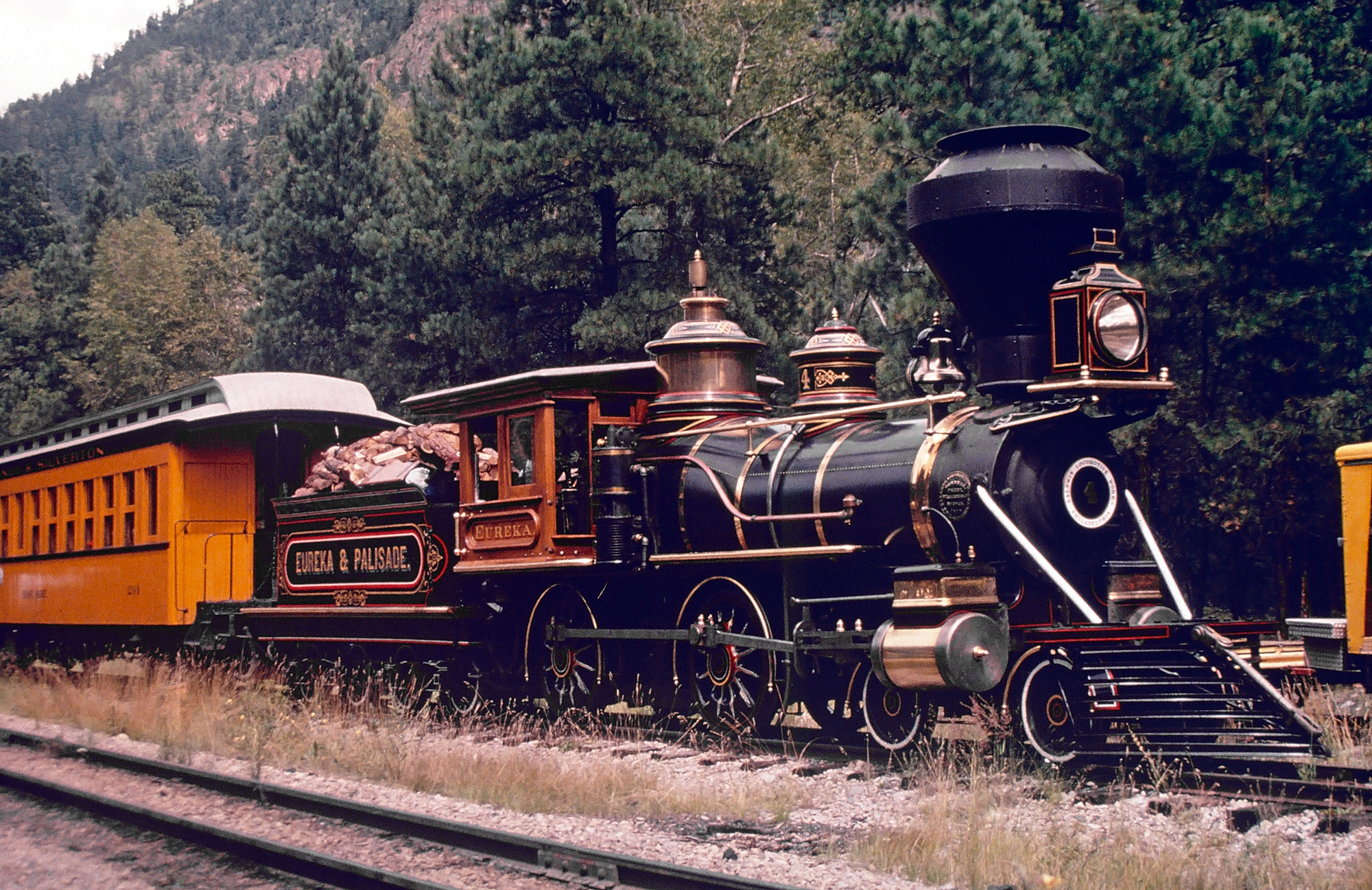 Eureka & Palisade 4-4-0 #4, a historic narrow-gauge steamer originally built by the leads a photo charter across the Pratt deck truss bridge over the Baldwin Locomotive Works in July, 1875, is seen here between photo runs on the Durango & Silverton in August, 1999. It is now privately owned and housed in Las Vegas, Nevada. Jerry Weisman photo. American-Rails.com collection.
Eureka & Palisade 4-4-0 #4, a historic narrow-gauge steamer originally built by the leads a photo charter across the Pratt deck truss bridge over the Baldwin Locomotive Works in July, 1875, is seen here between photo runs on the Durango & Silverton in August, 1999. It is now privately owned and housed in Las Vegas, Nevada. Jerry Weisman photo. American-Rails.com collection.Decline
Unfortunately, proponents soon realized Johnson's omen; for those railroads which actually saw service, few were more than 100 miles in length.
The idea of a national, transcontinental network was fading by the latter 1880's; in 1889 only 9,705 miles remained and had shrunk to just 6,733 miles by 1900. There were two principal ideas for this coast-to-coast network; neither garnered significant investment and only a few hundred miles were actually constructed.
Ironically, the Denver & Rio Grande Railway was to act as part of all three although Palmer had never actually envisioned his system as part of a through, east-to-west corridor.
The first was the idea of Major Peter B. Borst who chartered the Washington, Cincinnati & St. Louis Railroad on March 15, 1871 to link the cities in its name.
From St. Louis, it would connect with other prospective narrow gauges under development, notably the St. Louis & Leavenworth Narrow-Gauge (to link St. Louis with Leavenworth, Kansas) and the Kansas Central Railway (to run from Leavenworth to Denver).
Notable Lines
Denver, South Park & Pacific Railroad, "The South Park Line"
East Tennessee & Western North Carolina, "The Tweetsie"
East Broad Top Railroad & Coal Company
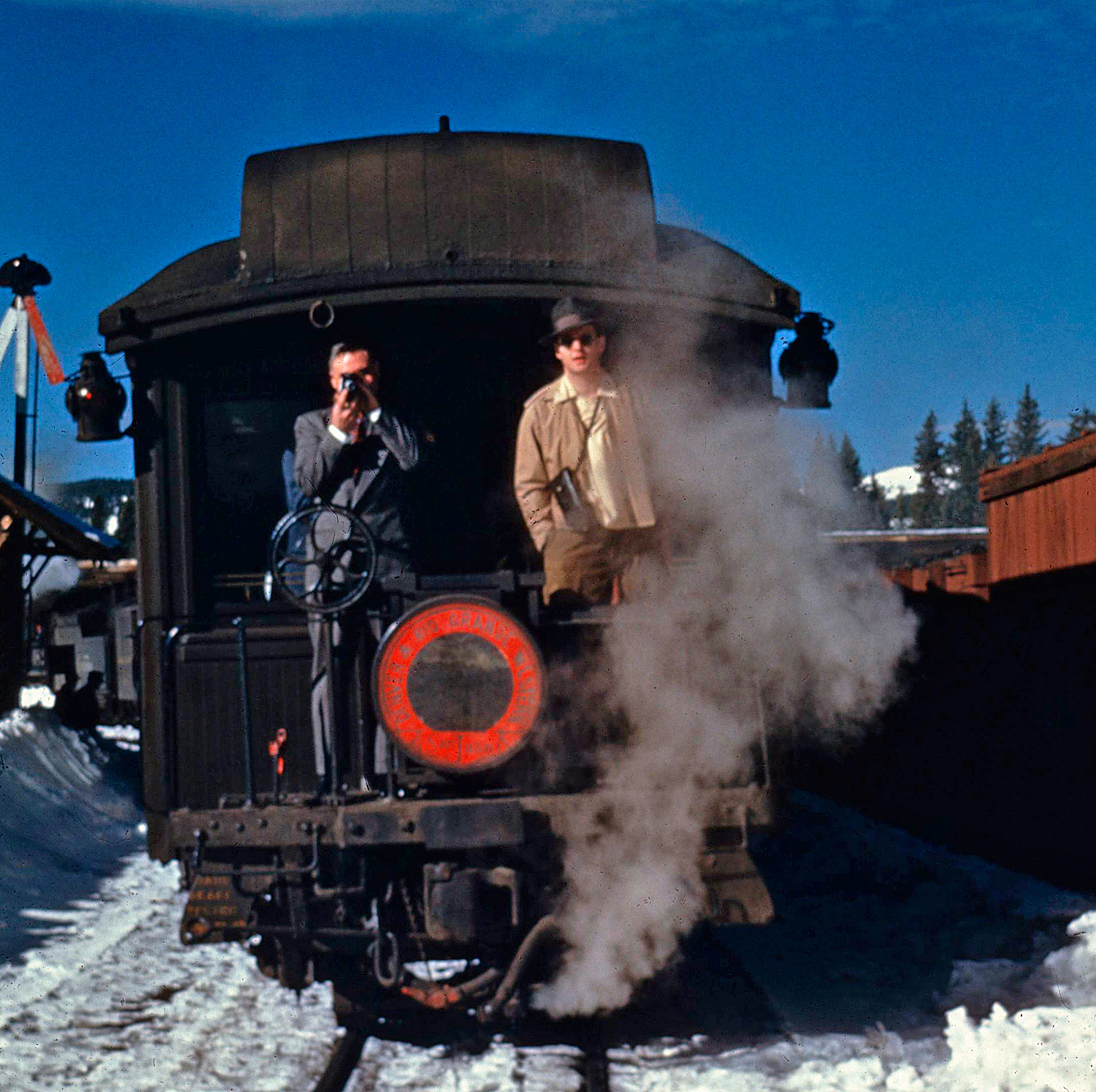 Two railfans pose on the rear platform of the parlor-observation attached to train #115, the "San Juan Express," stopped in Alamosa, Colorado on the morning of December 31, 1949. American-Rails.com collection.
Two railfans pose on the rear platform of the parlor-observation attached to train #115, the "San Juan Express," stopped in Alamosa, Colorado on the morning of December 31, 1949. American-Rails.com collection.The latter would link up with the Denver & Rio Grande for through service across the Rocky Mountains. Interestingly, he never explained how his transcontinental project would reach the west coast beyond Utah. The second project was the so-called "Grand Narrow Gauge Trunk."
Even more curious is the fact it was never projected to actually run from coast to coast. Instead, it comprised three U.S. railroads running between Ohio and the Mexican border; the Toledo, Cincinnati & St. Louis (Toledo, Ohio-St. Louis); St. Louis & Cairo (St. Louis-Cairo, Illinois); and the Texas & St. Louis (Cairo-Laredo, Texas).
At the Rio Grande River the T&StL would interchange with the Mexican National Railway to run 803 miles to Mexico City. Combined, the four systems would comprise a 2,445-mile network.
Unfortunately, most of these grand schemes barely made it off the paper they were written on. When these endeavors died so did the dream of a national network; the 4 feet, 8 1/2 inch gauge had been too well-established by the 1870's along with industry's monetary backing.
The narrow gauge's greatest success was as feeder branches, ironically the very thing many had suggested from the start. Of the three-foot corridors built during the 19th century, most wound up as branches of large trunk lines like the Baltimore & Ohio, Milwaukee Road, and Union Pacific.
Some, however, survived independently well into the 20th century such as the East Broad Top, East Tennessee & Western North Carolina, part of the Denver & Rio Grande Western, White Pass & Yukon, and the railroads of Hawaii (notably the Oahu Railway & Land Company) which were free from standard gauge competition.
Also of note were Maine's famous two-footers, which predominately served its timber industry. Today, some of the previously mentioned railroads survive as popular, and quite successful, tourist attractions.
Contents
Recent Articles
-
Oregon Railroad Museums: A Complete Guide
Apr 25, 25 03:11 PM
With its rich tapestry of scenic landscapes and profound historical significance, Oregon possesses several railroad museums that offer insights into the state’s transportation heritage. -
North Carolina Railroad Museums: A Complete Guide
Apr 25, 25 02:56 PM
Today, several museums in North Caorlina preserve its illustrious past, offering visitors a glimpse into the world of railroads with artifacts, model trains, and historic locomotives. -
New Jersey Railroad Museums: A Complete Guide
Apr 25, 25 11:48 AM
New Jersey offers a fascinating glimpse into its railroad legacy through its well-preserved museums found throughout the state.

